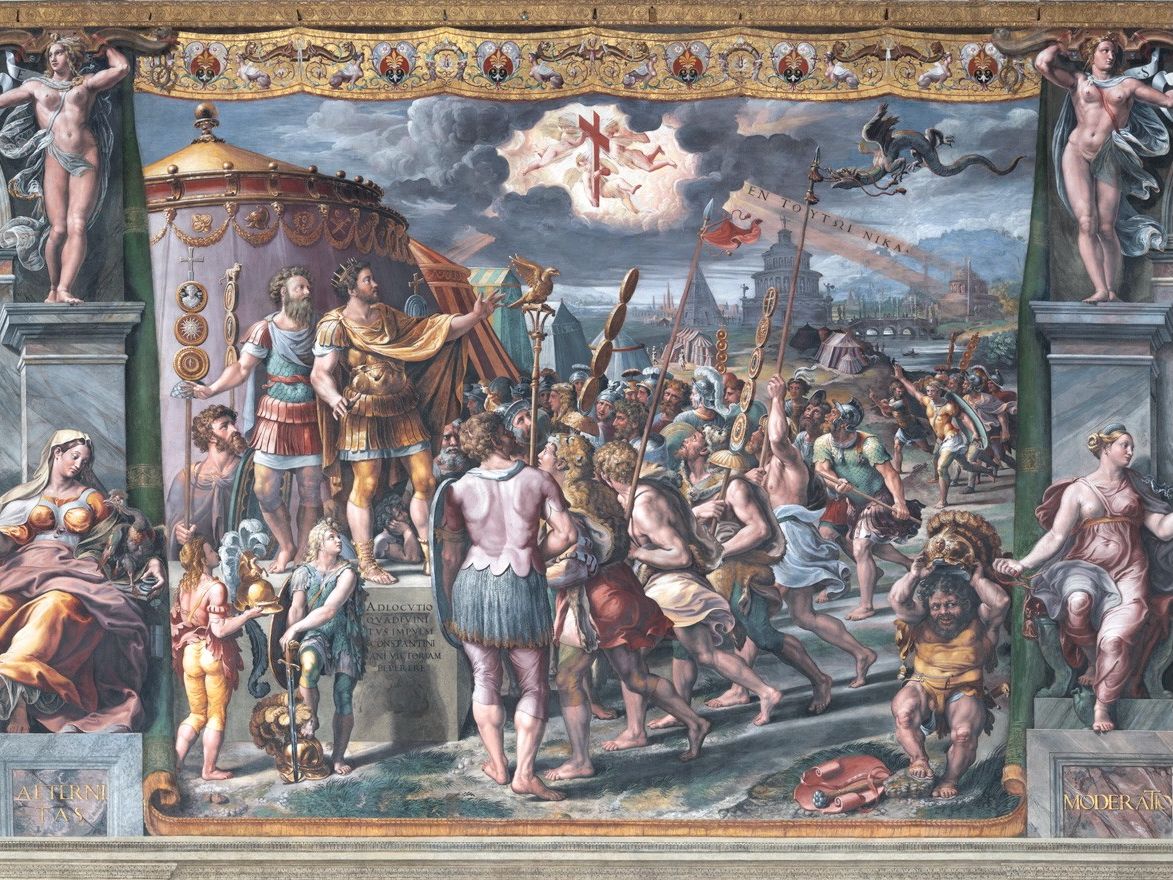
As specialists cleaned and studied the rooms in the Apostolic Palace, they learned new information about the Renaissance painter’s experimental techniques

The Hall of Constantine’s Vision of the Cross depicts the emperor ahead of his battle with Maxentius.
Vatican City State, Directorate of Museums and Cultural Heritage
Following extensive restorations, the Vatican Museums is opening the largest of the Raphael Rooms to the public. Located in the Apostolic Palace, the pope’s official residence, the rooms were painted by the Renaissance master and his students in the early 1500s.
The newly renovated room is called the Hall of Constantine. The restorations have revealed new insights into Raphael’s work, including details about an innovative technique he was testing out.
Quick fact: Where did the Hall of Constantine’s name come from?
The hall is named for the Roman emperor Constantine I, who converted to Christianity in 312 C.E.
“With this restoration, we rewrite a part of the history of art,” Vatican Museums director Barbara Jatta tells the Associated Press’ Nicole Winfield.
Raphael was a 25-year-old painter living in Florence when Pope Julius II asked him to decorate his new apartment in the palace in 1508. (The pope, an important patron of his day, commissioned Michelangelo’s paintings in the Sistine Chapel around the same time.)
Raphael envisioned his design as a series of murals depicting the triumph of Christianity over paganism: The Vision of the Cross, The Battle of the Milvian Bridge, The Baptism of Constantine and The Donation of Rome. The hall is “the most politically and programmatically important room in the complex,” Jatta explained at a recent press conference, per the Catholic News Agency’s Victoria Cardiel.
According to historical accounts, Raphael initially hadn’t wanted to paint traditional frescoes, which are made by applying paint to wet plaster. Instead, he’d hoped to use oils to achieve vibrant colors. Jatta says the experts knew Raphael experimented in the rooms, but they weren’t sure exactly where, per the Catholic News Agency.
The Battle of the Milvian Bridge depicts Constantine’s fight against Maxentius. Vatican City State, Directorate of Museums and Cultural Heritage/https://tf-cmsv2-smithsonianmag-media.s3.amazonaws.com/filer_public/45/e3/45e30a0a-c75a-4eb4-b226-0ac184b9119c/cq5damweb12801280.jpeg)
Early in the restoration project, experts discovered that two figures in the Hall of Constantine had been painted with oils. They are allegorical female forms representing Courtesy and Justice, as chief restorer Fabio Piacentini explains to the AP. He thinks these figures were the work of Raphael himself, rather than his students.
“We have two more [official] Raphaels in our catalog,” Jatta says to the AP. According to a statement from Vatican City, these figures were Raphael’s final pieces.
Along with the oil figures, restorers discovered a grid of nails embedded in the Hall of Constantine’s wall. They think Raphael inserted the nails to hold up a natural resin surface he intended to paint.
The Baptism of Constantine depicts the Roman emperor who converted to Christianity. Vatican City State, Directorate of Museums and Cultural Heritage/https://tf-cmsv2-smithsonianmag-media.s3.amazonaws.com/filer_public/86/6c/866cff20-3e5c-4ba8-bb00-465b07f8a1ac/cq5damweb12801280_2.jpeg)
“From a historical and critical point of view, and also technical, it was truly a discovery,” Piacentini tells the AP. “The technique used and planned by Raphael was truly experimental for the time, and has never been found in any other mural made with oil paint.”
The ten-year restoration gathered extensive data using techniques such as reflectography, infrared imaging, UV fluorescence and chemical analysis, according to the statement. Researchers also used laser scanning to document the rooms in a 3D model.
The Hall of Constantine was Raphael’s “last major decorative undertaking and represents a true technical revolution,” said Piacentini, per the Catholic News Agency. Experts say the embedded nails could suggest that Raphael intended to paint the whole room in oils. However, he died in 1520 before he could see his plans through.
Two of Raphael’s students, Giulio Romano and Giovanni Francesco Penni, completed the piece after their teacher’s death. When Raphael “left this Earth at the height of the Renaissance,” the artist “left behind a great tradition, which his students embraced,” Jatta tells the AP. Though they could only paint frescoes, they completed the Vatican rooms without him.

/https://tf-cmsv2-smithsonianmag-media.s3.amazonaws.com/accounts/headshot/Sonja_headshot.png)






